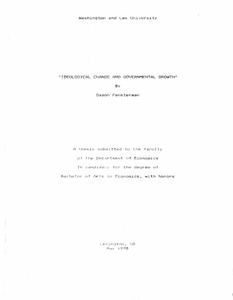| dc.rights.license | In Copyright | en_US |
| dc.creator | Fensterman, Damon | |
| dc.date.accessioned | 2023-10-20T17:40:41Z | |
| dc.date.available | 2023-10-20T17:40:41Z | |
| dc.date.created | 1990 | |
| dc.identifier | WLURG038_Fensterman_thesis_1990 | |
| dc.identifier.uri | https://dspace.wlu.edu/handle/11021/36390 | |
| dc.description.abstract | A fruitful approach seems to be an examination of ideological trends. As I have shown, this approach, when applied specifically to agriculture, yields valuable insight. It seems likely that the same approach, when applied to other areas of government control, and when intensified, would yield similar fruit. This application to the agricultural sector suggests several conclusions. Governmental growth does not seem to ratchet upward as a result of crises, at least not in the way Higgs suggests. Rather, crisis seems to induce radical change, and these changes remain (in greater or lesser magnitude) because the perceived crisis remains. Secondly, twentieth century governmental growth can be seen as a result of converging intellectual and sociopolitical trends whose roots lie deep in the nineteenth century. The populist movements of the 1870s, 80s, and 90s gave birth to a political movement which did not last. But the children of that movement carried the seeds of a new movement which would transform the face of government forever. And the same populist movement birthed an intellectual tradition which first bore fruit during WW I. By the time the Great Depression hit, the second generation of agricultural
economists was plying its influence. Moreover, the very presence of such intellectuals in Washington -- a rarity before WW I -- inspired Roosevelt to gather such minds around him, thus giving them an unprecedented influence. These two trends converged at an opportune time and place, and the result was a giant step forward for the federal government. I argue that if the Depression had happened twenty years earlier, we may not have observed the same ratchet phenomenon. Moreover, we cannot base a theory of twentieth century government on this one unique period. [From Conclusion] | en_US |
| dc.format.extent | 58 pages | en_US |
| dc.language.iso | en_US | en_US |
| dc.rights | This material is made available for use in research, teaching, and private study, pursuant to U.S. Copyright law. The user assumes full responsibility for any use of the materials, including but not limited to, infringement of copyright and publication rights of reproduced materials. Any materials used should be fully credited with the source. | en_US |
| dc.rights.uri | http://rightsstatements.org/vocab/InC/1.0/ | en_US |
| dc.subject.other | Washington and Lee University -- Honors in Economics | en_US |
| dc.title | Ideological Change and Governmental Growth | en_US |
| dc.type | Text | en_US |
| dcterms.isPartOf | WLURG038 - Student Papers | en_US |
| dc.rights.holder | Fensterman, Damon | en_US |
| dc.subject.fast | Ideology | en_US |
| dc.subject.fast | Political science | en_US |
| dc.subject.fast | Agriculture and state | en_US |
| local.department | Economics | en_US |
